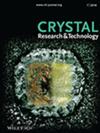温度和pH对磷酸钙沉淀的影响
IF 1.9
4区 材料科学
Q3 CRYSTALLOGRAPHY
引用次数: 7
摘要
正磷酸钙(CaP)的合成涉及几个化学平衡,这些平衡定义了最终产品中存在的相。从生物材料的角度来看,了解合成参数如何影响相形成和颗粒大小是很重要的。本研究评估了温度(24°C或45°C)和pH条件(4.5、6.5或漂移)对CaP沉淀在产量、相形成、密度、形态和尺寸分布方面的相互作用。将钙和磷酸盐溶液(Ca/P = 1.0)混合并搅拌3小时。将沉淀冷冻干燥并进行表征。在漂移pH和pH 4.5条件下,磷酸二钙二水合物(DCPD, CaHPO4 × 2H2O)是两种温度下的主要相;然而,一些样品也存在归因于无水磷酸二钙(DCPA, CaHPO4)的峰。在pH 6.5时,衍射图显示低结晶度DCPD和DCPA(24°C)或低结晶度羟基磷灰石[HAP, Ca10(OH)2(PO4)6](45°C)的混合物。尽管形貌不同(片状或聚集体),但颗粒尺寸仍然在一个相对狭窄的范围内(D50 = 12-28µm)。偏酸性或漂移pH条件下有利于DCPD沉淀,而接近中性pH 6.5条件下有利于HAP形成。本文章由计算机程序翻译,如有差异,请以英文原文为准。
Effect of Temperature and pH on Calcium Phosphate Precipitation
Calcium orthophosphates (CaP) synthesis involves several chemical equilibria that define the phases present in the final product. From the biomaterials standpoint, it is important to gain knowledge on how synthesis parameters affect phase formation and particle size. This study evaluates the interaction between temperature (24 or 45 °C) and pH conditions (4.5, 6.5, or drifting) on CaP precipitation in terms of yield, phase formation, density, morphology, and size distribution. Calcium and phosphate solutions (Ca/P = 1.0) are mixed and kept under stirring for 3 h. The precipitate is freeze‐dried and characterized. Under drifting pH and pH 4.5, dicalcium phosphate dihydrate (DCPD, CaHPO4 × 2H2O) is the predominant phase at both temperatures; however, some samples also present peaks ascribed to dicalcium phosphate anhydrous (DCPA, CaHPO4). At pH 6.5, diffractograms reveal a mixture of low‐crystallinity DCPD and DCPA (24 °C) or low crystallinity hydroxyapatite [HAP, Ca10(OH)2(PO4)6] (45 °C). In spite of the different morphologies (plates or aggregates), particle size remains within a relatively narrow range (D50 = 12–28 µm). DCPD precipitation is favored under more acidic or drifting pH, while HAP is formed under nearly neutral pH 6.5.
求助全文
通过发布文献求助,成功后即可免费获取论文全文。
去求助
来源期刊
自引率
6.70%
发文量
121
审稿时长
1.9 months
期刊介绍:
The journal Crystal Research and Technology is a pure online Journal (since 2012).
Crystal Research and Technology is an international journal examining all aspects of research within experimental, industrial, and theoretical crystallography. The journal covers the relevant aspects of
-crystal growth techniques and phenomena (including bulk growth, thin films)
-modern crystalline materials (e.g. smart materials, nanocrystals, quasicrystals, liquid crystals)
-industrial crystallisation
-application of crystals in materials science, electronics, data storage, and optics
-experimental, simulation and theoretical studies of the structural properties of crystals
-crystallographic computing

 求助内容:
求助内容: 应助结果提醒方式:
应助结果提醒方式:


